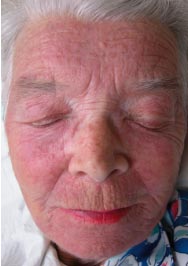Adult Eczema Conditions

Atopic Dermatitis (Eczema)
The skin barrier
Genes and the environment
Elidel - a non-steroidal cream
The cost and impact of eczema
· People with eczema can spend up to $1,200 annually on treatments, depending on the severity of their eczema16· Eczema has a significant impact on quality of life and may affect daily routines1· On average, people with eczema spend 1 out of every 3 days in a flare17· During flares people avoid everyday activities, suffer from sleep disturbances and have to take time off school / work.171. Marks R et al. The prevalence of common skin conditions in Australian school student: 2. Atopic Dermatits. British Journal of Dermatology 1999; 140: 468-473
2. Foley P et al. The frequency of common skin Conditions in preschool-age children in Australia Arch Dermatol 2001; 137: 293-300
3. Plunkett A et al. The frequency of common non malignant skin condition in adults in central Victoria, Australia International Journal of Dermatology 1999,38,901-908
4. Bannister M, Freeman S. Adult-onset atopic dermatitis. Australasian Journal of Dermatology (2000) 41, 225-228.
5. Su J et al. Atopic eczema: its impact on the family and financial cost. Arch Dis Child 1997; 76: 159-162.
6. Cork et al. Predisposition to sensitive skin and atopic eczema. Community Practitioner 2005; 78, 12: 440-442.
7. Cork et al. New perspectives on epidermal barrier dysfunction in atopic dermatitis: gene-environment interactions. J Allergy Clin Immunol 2006; 118: 3-21.
8. Hoetzenecker W et al. Pimecrolimus leads to an apoptosis-induced depletion of T Cells but not Langerhans cells in patients with atopic dermatitis. J Allergy Clin Immunol 2005; 115 (6) 1276-83.9. Lieberman, P et al. Allergic Diseases, Diagnosis and Treatment 2nd Ed. Humana Press, New Jersey.
10. Elidel Product Information, Novartis Pharmaceuticals, 2006.
11. Therapeutic Guidelines Dermatology, Version 2, 2004.
12. Hultsch T et al. Dermatology 211, 2005: 174-187.
13. Grassberger M et al. A novel anti-inflammatory drug, SDZASM981, for the treatment of skin diseases in vitro pharmacology. Br J Dermatol 1999; 141(1): 264-73. III F 47 156.
14. Meingassner J et al. A novel anti-inflammatory drug, SDZ ASM 981, for the topical and oral treatment of skin diseases in vivo pharmacology. Br J Dermatol 1997; 137(1):568-76.
15. Meurer et al. Pimecroliums cream in the long-term management of atopic dermatitis in adults: a six-month study. Dermatology 2002; 205: 271-277
16. Kemp A. Cost of illness of atopic dermatitis in children. A societal perspective. Pharmacoeconomics 2003; 21 (2): 105-113.
17. Zuberbier T et al. Patient perspectives on the management of atopic dermatitis (ISOLATE). J Allergy and Clin Immunol 2006; 118: 226-32.
MORE
- Menstrual Period Management
- The Secret to Weight Loss
- Feeling The Pain: How To Tackle Period Pain
- Period Pain and How to Survive It
- Gender Specific Medicine
- Helping Women To Start Those 'Difficult'...
- Michelle Boyd Ellura Interview
- Menopause Does Not Protect Women From Cervical...
- Five Ways to Balance Hormones
- Do You Really Know What Is Going On Down There?
- Do You Know Your Breasts?
- Dr. Stan Goldstein Sexual Health Choices Interview
- Breast Health Decision Question and Answers
- Breast Cancer Treatment Impacts Patients' Sex...
- Bladder Weakness More Common Than Hay Fever
- Belinda Reynolds How To Manage UTI's Naturally...
- Treat Bones Like Breasts
- Mammogram Technology
- Soodox for Women
- Chlamydia Most Commonly Reported STI In Australia
- Time For Reflection Is Great For Mental Health
Copyright © 2001 - Female.com.au, a Trillion.com Company - All rights reserved. 6-8 East Concourse, Beaumaris, Vic 3193, Australia.



